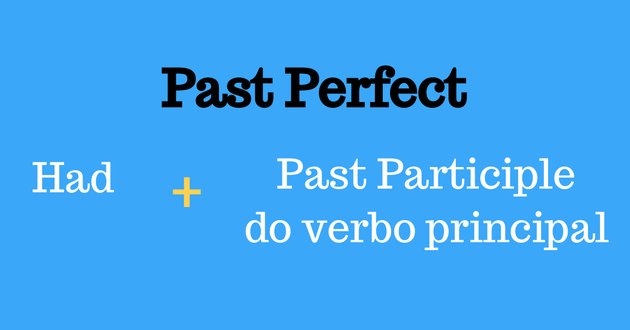Past Perfect
O Past Perfect ou Past Perfect Simple (Passado Perfeito ou Passado Perfeito Simples) é um tempo verbal usado para expressar ações passadas que aconteceram antes de outra ação que também ocorrera no passado.
Nesse tempo verbal é comum as frases serem formadas por alguns advérbios.
Os mais utilizados são:
- when (quando)
- just (acabado de; há pouco)
- already (já)
- by the time (no momento)
- ever (já; alguma vez)
- never (nunca)
- before (antes)
- after (depois)
Exemplos:
- I had already cleaned the house when my mother arrived. (Eu já tinha limpado a casa quando minha mãe chegou.)
- She had just left by the time he arrived. (Ela tinha acabado de sair quando ele chegou.)
- They did not come with us because they had visited this museum before. (Eles não vieram conosco porque tinham visitado este museu antes.)
- He asked me if I had ever been to Germany. (Ele me perguntou se eu já tinha estado na Alemanha.)
Formação do Past Perfect
O Past Perfect é formado pelo verbo auxiliar to have conjugado no Simple Past (had) + Past Participle do verbo principal.

Atenção! (Pay Attention!)
Todos os verbos regulares seguem um modelo de conjugação. No particípio passado, as flexões sempre são formadas pelo acréscimo das terminações –d, –ed ou –ied
Já os verbos irregulares, não seguem nenhum modelo ou regra de conjugação. Assim sendo, a melhor forma de conhecer suas flexões é consultar uma tabela de verbos.
Exemplos:
- Verbo to dance (regular) - particípio passado: danced
- Verbo to play (regular) - particípio passado: played
- Verbo to study (regular) - particípio passado: studied
- Verbo to go (irregular) - particípio passado: gone
- Verbo to be (irregular) - particípio passado: been
Forma afirmativa (affirmative form)
As frases afirmativas no Past Perfect Simple são formadas da seguinte maneira:
Sujeito + verbo to have no Simple Past (had) + verbo principal no Past Participle + complemento
Exemplo:
You had changed your clothes before the end of the party. (Você tinha mudado suas roupas antes do final da festa).
Forma Negativa (negative form)
Nas frases negativas é necessário acrescentar o not após o verbo auxiliar:
Sujeito + verbo to have no Simple Past (had) + not + verbo principal no Past Participle + complemento
Exemplo:
You had not changed your clothes before the end of the party. (Você não tinha mudado suas roupas antes do final da festa.)
Obs.: a forma negativa também pode ser escrita na forma contraída: had + not = hadn't
Exemplo:
You hadn't changed your clothes before the end of the party. (Você não tinha mudado suas roupas antes do final da festa.)
Forma Interrogativa (interrogative form)
Para fazer perguntas no Past Perfect Simple, o verbo auxiliar deve ser usado no início da frase, antes do sujeito:
Verbo to have no Simple Past + sujeito + verbo principal no Past Participle + complemento
Exemplo:
Had you changed your clothes before the end of the party? (Você tinha mudado suas roupas antes do fim da festa?)
Past Perfect Simple x Past Perfect Continuous
No Past Perfect Tense há duas formas de expressar ações passadas. Vejamos abaixo cada uma delas:
Past Perfect Simple
É usado para indicar ações no passado que ocorreram antes de outra ação no passado.
O Past Perfect Simple é formado pelo verbo auxiliar to have conjugado no Simple Past (had) + Past Participle do verbo principal.
Exemplos:
- I had finished the job when my boss arrived. (Eu tinha terminado o trabalho quando meu chefe chegou.) - AFFIRMATIVE FORM
- I had not finished the job when my boss arrived. (Eu não tinha terminado o trabalho quando meu chefe chegou.) - NEGATIVE FORM
- Had I finished the job when my boss arrived? (Eu tinha terminado o trabalho quando meu chefe chegou?) - INTERROGATIVE FORM
Past Perfect Continuous
É usado para indicar a continuidade de ações no passado que ocorreram antes de outra ação no passado.
O Past Perfect Continuous é formado pelo verbo to have conjugado no Simple Past (had) + verbo to be conjugado no Past Participle (been) + gerúndio do verbo principal.
Exemplos:
- I had been waiting for two hours when she arrived. (Eu tinha estado esperando por duas horas quando ela chegou.) - AFFIRMATIVE FORM
- I had not been waiting for two hours when she arrived. (Eu não tinha estado esperando por duas horas quando ela chegou.) - NEGATIVE FORM
- Had I been waiting for two hours when she arrived? (Eu tinha estado esperando por duas horas quando ela chegou?) - INTERROGATIVE FORM
Complemente sua pesquisa sobre os verbos em inglês:
Vídeo (Video)
Assista o vídeo abaixo com um resumo do uso do Past Perfect e fique por dentro desse tempo verbal.
Exercícios (Exercises)
1. (Fundatec/2015)
Press me! The button that lies to you
The tube pulls in to a busy station along the London Underground’s Central Line. It is early evening on a Thursday. A gaggle of commuters assembles inside and outside the train, waiting for the doors to open. A moment of impatience grips one man who is nearest to them. He pushes the square, green-rimmed button which says “open”. A second later, the doors satisfyingly part. The crowds mingle, jostling on and off the train, and their journeys continue. Yet whether or not the traveller knew it, his finger had no effect on the mechanism.
Some would call this a “placebo button”– a button which, objectively speaking, provides no control over a system, but which to the user at least is psychologically fulfilling to push. It turns out that there are plentiful examples of buttons which do nothing and indeed other technologies which are purposefully designed to deceive us. But here’s the really surprising thing. Many increasingly argue that we actually benefit from the illusion that we are in control of something – even when, from the observer’s point of view, we’re not.
In 2013, BBC News Magazine discovered that pedestrian crossings all over the UK were the wellspring of placebo buttons. A crossing in central London had programmed intervals for red and green lights, for example. Pushing the button would only impact the length of these intervals between midnight and 7am. ___ several other cities during busy periods, the crossings were programmed to alternate their signals at a specific rate. The buttons did nothing, but a “wait” light would still come on when they were pressed and, yes, people still pressed them presumably believing that their actions were having an effect.
Certain psychologists would argue that the buttons were indeed having an effect – just not ___ the traffic lights themselves. Instead the effect is in the commuter’s minds. To understand this you have to go back to the early 1970s. At that time, psychologist Ellen Langer, now a professor ____ Harvard, was a Yale graduate student. During a five-card draw game of poker she dealt one set of cards in a haphazard order. “Everybody,” she says, “got crazy. The cards somehow belonged to the other person even though you couldn’t see any of them.” Langer decided to find out more about the way people regulated the playing of such games. She went to a casino where, at the slot machines, she found gamblers with elaborate ways of pulling the lever. At another time a “highly rational” fellow student tried to explain to her why tossing a pair of dice could be done in a certain way to affect the numbers which came up. “People believed that all of these behaviours were going to increase the probability of their winning,” she comments.
In 1975, she wrote a paper where she described the significance of these beliefs and coined a term for the effect that they had on people: the “illusion of control”. However, instead of framing this as an irrational delusion, Langer described the effect as a positive thing. “Feeling you have control over your world is a desirable state,” she explains. When it comes to those deceptive traffic light buttons, Langer says there could be a whole host of reasons why the placebo effect might be counted as a good thing. “Doing something is better than doing nothing, so people believe,” she says. “And when you go to press the button your attention is on the activity at hand. If I’m just standing at the corner, I may not even see the light change, or I might only catch the last part of the change, in which case I could put myself in danger.”
Also, if pedestrians wait together at the crossing and a few press the button impatiently, that creates a sense of togetherness with strangers which might otherwise be absent. All of these things may be taken as positive impacts on our mental state, and even socially reinforcing. It’s something to think about next time you cross the street.
(Source: Adapted from http://www.bbc.com/future/story/20150415-the-buttons-that-do-nothing)
In the sentence “A crossing in central London had programmed intervals for red and green lights”, the underlined verbal locution is in the ________________. If we put it in the present perfect continuous, it would be written as ______________.
Mark the alternative that correctly and respectively fill in the blanks above.
a) past perfect - had been programming
b) past perfect - has been programming
c) present perfect - have been programmed
d) present perfect - have being programmed
e) simple past - has programming
2. Qual das frases abaixo não está no Past Perfect Simple:
a) Had you been waiting long before the airplane arrived?
b) You had not studied English before you moved to Brazil.
c) We had had that car for fifteen years before it broke down.
d) Before I came here, I had spoken to Jonh.
e) He had written a letter to Carlos.
3. Escreva a frase abaixo no Past Perfect Simple nas formas afirmativa, negativa e interrogativa:
I watched a good film this weekend.
4. Conjugue o verbo to have na forma afirmativa do Past Perfect Simple:
MUNIZ, Carla. Past Perfect. Toda Matéria, [s.d.]. Disponível em: https://www.todamateria.com.br/past-perfect-simple/. Acesso em:


